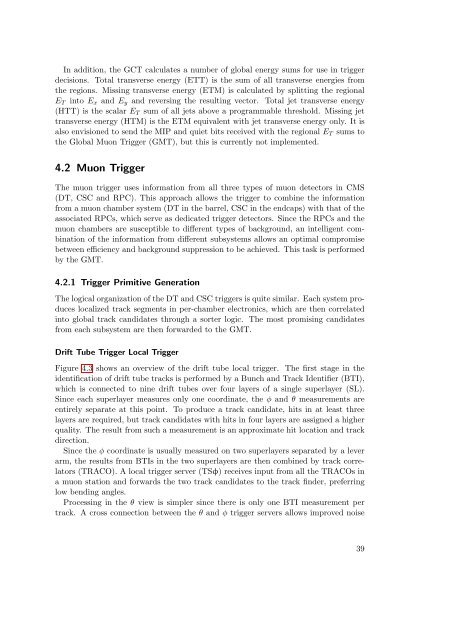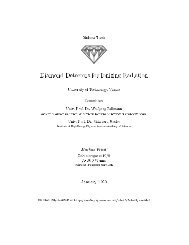Create successful ePaper yourself
Turn your PDF publications into a flip-book with our unique Google optimized e-Paper software.
In addition, the GCT calculates a number of global energy sums for use in triggerdecisions. Total transverse energy (ETT) is the sum of all transverse energies fromthe regions. Missing transverse energy (ETM) is calculated by splitting the regionalE T into E x and E y and reversing the resulting vector. Total jet transverse energy(HTT) is the scalar E T sum of all jets above a programmable threshold. Missing jettransverse energy (HTM) is the ETM equivalent with jet transverse energy only. It isalso envisioned to send the MIP and quiet bits received with the regional E T sums tothe Global Muon Trigger (GMT), but this is currently not implemented.4.2 Muon TriggerThe muon trigger uses information from all three types of muon detectors in CMS(DT, CSC and RPC). This approach allows the trigger to combine the informationfrom a muon chamber system (DT in the barrel, CSC in the endcaps) with that of theassociated RPCs, which serve as dedicated trigger detectors. Since the RPCs and themuon chambers are susceptible to different types of background, an intelligent combinationof the information from different subsystems allows an optimal compromisebetween efficiency and background suppression to be achieved. This task is performedby the GMT.4.2.1 Trigger Primitive GenerationThe logical organization of the DT and CSC triggers is quite similar. Each system produceslocalized track segments in per-chamber electronics, which are then correlatedinto global track candidates through a sorter logic. The most promising candidatesfrom each subsystem are then forwarded to the GMT.Drift Tube Trigger Local TriggerFigure 4.3 shows an overview of the drift tube local trigger. The first stage in theidentification of drift tube tracks is performed by a Bunch and Track Identifier (BTI),which is connected to nine drift tubes over four layers of a single superlayer (SL).Since each superlayer measures only one coordinate, the φ and θ measurements areentirely separate at this point. To produce a track candidate, hits in at least threelayers are required, but track candidates with hits in four layers are assigned a higherquality. The result from such a measurement is an approximate hit location and trackdirection.Since the φ coordinate is usually measured on two superlayers separated by a leverarm, the results from BTIs in the two superlayers are then combined by track correlators(TRACO). A local trigger server (TSφ) receives input from all the TRACOs ina muon station and forwards the two track candidates to the track finder, preferringlow bending angles.Processing in the θ view is simpler since there is only one BTI measurement pertrack. A cross connection between the θ and φ trigger servers allows improved noise39












